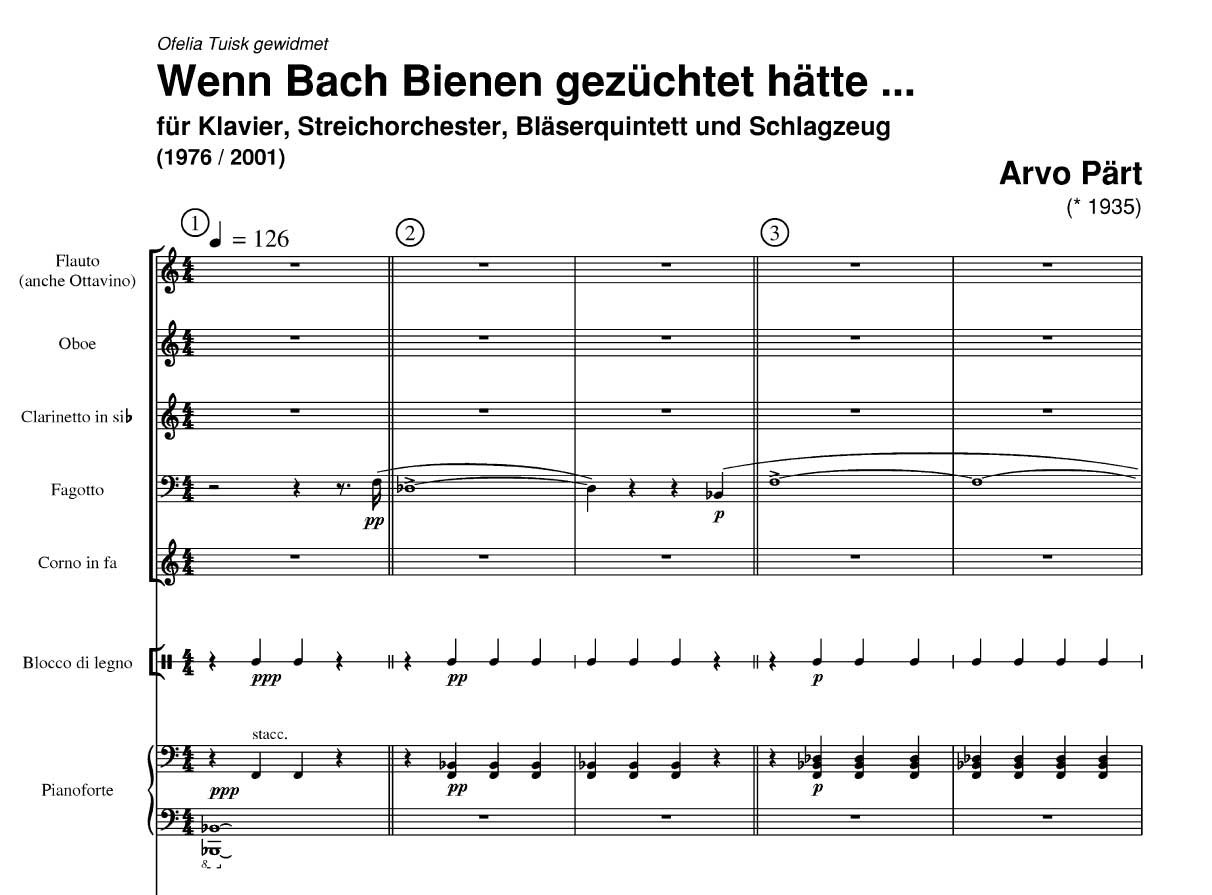If Bach Had Been a Beekeeper …, completed in 1976, is one of the works performed at the legendary concert by Hortus Musicus on 27 October of the same year, where the audience heard for the first time the word ‘tintinnabuli’ (tintinnabulum – Latin for ‘little bell’) as the title of the first part of the composition. This marked the beginning of Pärt’s new creative style. Intensive creative collaboration with the early music ensemble offered the composer an opportunity to use instruments played by the ensemble and experiment with their sounds. Works performed at the concert, including Für Alina, In spe, Pari intervallo and Modus (later renamed Sarah Was Ninety Years Old), only later received a fixed instrumentation. T…
If Bach Had Been a Beekeeper …, completed in 1976, is one of the works performed at the legendary concert by Hortus Musicus on 27 October of the same year, where the audience heard for the first time the word ‘tintinnabuli’ (tintinnabulum – Latin for ‘little bell’) as the title of the first part of the composition. This marked the beginning of Pärt’s new creative style. Intensive creative collaboration with the early music ensemble offered the composer an opportunity to use instruments played by the ensemble and experiment with their sounds. Works performed at the concert, including Für Alina, In spe, Pari intervallo and Modus (later renamed Sarah Was Ninety Years Old), only later received a fixed instrumentation. The current version of If Bach Had Been a Beekeeper … is for piano, wind quintet, string orchestra and percussion (2021). The work is dedicated to the music critic Ofelia Tuisk (1919–1981), a fierce supporter of Arvo Pärt’s music in the harrowing conditions of the Soviet cultural policy. Her uncompromising responses to the critique against music composed by Pärt and others can be read from the minutes of the meetings of the Estonian Composers Union and the musical press at the time.
The key to understanding the sound of the composition is provided by an ironic title Pärt initially gave it: Portrait of a Musicologist Against the Background of a Wasp Nest. The work combines previously used compositional techniques with the sound of the new tintinnabuli style. The letters of Bach’s name, b–a–c–h, appear on several levels. It is presented as a melodic motif by means of the tremolo and sul ponticello techniques in the string parts reminiscent of the buzzing of bees: first, it appears in the viola part, then using various other instruments, starting from each note of the unit (violas play B-flat, A, C and B natural*, cellos A, G-sharp, B natural and A-sharp, first violins C, B natural, D and C-sharp, and second violins B natural, A-sharp, D-flat and C), so that in the end together they form a sound like a buzzing cloud of insects. The rhythmic pulse of the accompanying piano part consists of chords in B flat, A, C and B minors. The work culminates in a coda featuring the music from J. S. Bach's prelude in B minor from The Well-Tempered Clavier, Book 1. The first half of Bach’s slowly paced prelude in B minor, featured here at half the speed, offers a contrast to the previously tense music with its unstable tonality. However, Bach’s three-voice prelude is not presented here as a pure quote, but each of the three voices of the prelude is added by a tintinnabuli voice as a comment. With their neutral and delicate sound, these seem to give a new dimension to the music. Hopeful lightness is achieved with a method highly characteristic of Baroque music: resolving the cadenza so that the final chord is not played in the original minor, but in the major of the same tonality. Much later, Pärt has also used this soft “fusion” with the work of another composer in his Mozart-Adagio (1992/2005).
* In German musical nomenclature the note B flat is named B and the B natural named H.
